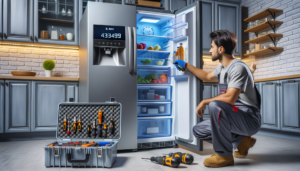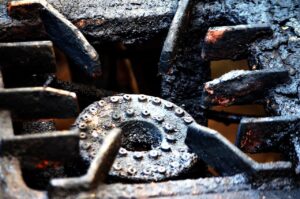Refrigerators are an essential appliance in every household, keeping our food fresh and preventing spoilage. However, like any other appliance, refrigerators can experience issues over time. One common problem that many people face is a refrigerator not defrosting properly. This can lead to a buildup of ice, water leakage, and even spoiled food. In this blog post, we will explore the basics of refrigerator defrosting, common causes of defrosting problems, signs of a refrigerator not defrosting properly, how to diagnose and fix the issue, and tips for preventing future problems.
Key Takeaways
- Defrosting is a necessary process for refrigerators to function properly.
- Common causes of defrosting problems include faulty defrost timers, heaters, and thermostats.
- Signs of a refrigerator not defrosting properly include frost buildup, warm temperatures, and unusual noises.
- Diagnosing a defrosting issue requires basic knowledge of refrigerator components and testing equipment.
- Tools needed to fix a refrigerator not defrosting include a multimeter, screwdrivers, and pliers.
Understanding the Basics of Refrigerator Defrosting
To understand why defrosting is necessary, it’s important to have a basic understanding of how refrigerators work. Refrigerators work by removing heat from the inside and releasing it outside, which keeps the temperature inside the refrigerator cool. This process involves the circulation of refrigerant through a series of coils and compressors.
Defrosting is necessary because as the refrigerant circulates through the evaporator coils, it can cause moisture in the air to freeze on the coils. Over time, this ice buildup can restrict airflow and prevent the refrigerator from cooling properly. To prevent this from happening, refrigerators are equipped with defrosting systems that periodically melt the ice on the coils.
There are three main types of defrosting systems: manual defrost, automatic defrost, and frost-free. Manual defrost refrigerators require the user to manually turn off the refrigerator and remove all food to allow the ice to melt. Automatic defrost refrigerators have a timer that periodically turns off the cooling system and activates a heating element to melt the ice. Frost-free refrigerators use fans and sensors to monitor and control the temperature and humidity inside the refrigerator, preventing ice buildup.
Common Causes of Refrigerator Defrosting Problems
There are several common causes of refrigerator defrosting problems. One of the most common causes is a buildup of ice on the evaporator coils. This can occur if the defrost system is not functioning properly or if the door gaskets are not sealing properly, allowing warm air to enter the refrigerator.
Another common cause of defrosting problems is a malfunctioning defrost timer, thermostat, or heater. The defrost timer controls when the defrost cycle should occur, while the thermostat monitors the temperature inside the refrigerator and activates the defrost cycle when necessary. If either of these components is faulty, it can prevent the refrigerator from defrosting properly.
Faulty door gaskets can also cause defrosting problems. If the door gaskets are worn or damaged, they may not seal properly, allowing warm air to enter the refrigerator and causing ice buildup on the coils.
Finally, dirty condenser coils can also contribute to defrosting problems. If the condenser coils are covered in dust and debris, they may not be able to release heat properly, causing the refrigerator to work harder and potentially leading to ice buildup.
Signs of a Refrigerator Not Defrosting Properly
There are several signs that indicate a refrigerator is not defrosting properly. One of the most obvious signs is a buildup of frost or ice in the freezer. If you notice that your freezer has a layer of frost or ice on the walls or shelves, it’s likely that your refrigerator is not defrosting properly.
Another sign of a defrosting issue is water leaking from the refrigerator. When ice melts during the defrost cycle, it should drain into a pan located at the bottom of the refrigerator. If this drain becomes clogged or blocked, water can overflow and leak onto the floor.
Unusual noises coming from the refrigerator can also indicate a defrosting problem. If you hear loud popping or cracking sounds coming from your refrigerator, it could be a sign that the ice on the coils is expanding and contracting during the defrost cycle.
Lastly, if you notice that your food is spoiling faster than usual, it could be a sign that your refrigerator is not cooling properly due to ice buildup on the coils.
How to Diagnose a Defrosting Issue in Your Refrigerator
If you suspect that your refrigerator is not defrosting properly, there are several steps you can take to diagnose the issue. First, you should check the evaporator coils for any signs of ice buildup. If you see a thick layer of ice on the coils, it’s likely that your refrigerator is not defrosting properly.
Next, you should check the defrost timer, thermostat, and heater for any signs of malfunction. The defrost timer is usually located inside the control panel of the refrigerator and can be manually turned to activate the defrost cycle. The thermostat can be tested using a multimeter to ensure it is functioning properly. The heater can also be tested using a multimeter to check for continuity.
If all of these components are functioning properly, you should check the door gaskets for any signs of wear or damage. If the gaskets are not sealing properly, warm air can enter the refrigerator and cause ice buildup on the coils.
Tools You Need to Fix a Refrigerator Not Defrosting

To fix a refrigerator not defrosting properly, you will need several tools. These tools include a multimeter, screwdrivers (both Phillips and flathead), pliers, a hairdryer or heat gun, and a flashlight.
A multimeter is essential for testing the defrost timer, thermostat, and heater for continuity. Screwdrivers are needed to remove any panels or covers that may be blocking access to these components. Pliers may be needed to remove or tighten any screws or connectors.
A hairdryer or heat gun can be used to melt any ice buildup on the evaporator coils. Finally, a flashlight can be helpful for inspecting hard-to-reach areas inside the refrigerator.
Tips for Troubleshooting a Refrigerator Defrosting Problem
When troubleshooting a refrigerator defrosting problem, there are several common mistakes to avoid. First, it’s important to unplug the refrigerator before attempting any repairs or troubleshooting. This will prevent any electrical shocks or damage to the appliance.
Second, it’s important to follow safety precautions when working with electrical components. Always use insulated tools and wear protective gloves and eyewear to prevent injury.
When troubleshooting, it’s also important to take your time and carefully inspect each component. Look for any signs of wear or damage, and test each component thoroughly before replacing it.
Lastly, it’s important to consult the refrigerator’s manual or seek professional help if you are unsure about any aspect of the troubleshooting process. Refrigerators can be complex appliances, and it’s always better to be safe than sorry.
How to Fix a Refrigerator Not Defrosting: Step-by-Step Guide
If you have diagnosed a defrosting issue in your refrigerator and have the necessary tools, you can attempt to fix the problem yourself. Here is a step-by-step guide to fixing a refrigerator not defrosting properly:
1. Unplug the refrigerator and remove all food from the freezer.
2. Remove any panels or covers that may be blocking access to the evaporator coils, defrost timer, thermostat, or heater.
3. Use a hairdryer or heat gun to melt any ice buildup on the evaporator coils.
4. Test the defrost timer, thermostat, and heater for continuity using a multimeter.
5. If any of these components are faulty, replace them with new ones.
6. Inspect the door gaskets for any signs of wear or damage. If necessary, replace them with new ones.
7. Clean the condenser coils using a vacuum cleaner or brush to remove any dust or debris.
8. Reassemble the refrigerator and plug it back in.
9. Monitor the refrigerator for a few days to ensure that it is defrosting properly.
Preventing Future Refrigerator Defrosting Issues
To prevent future refrigerator defrosting issues, it’s important to maintain your refrigerator properly. Here are some tips for preventing problems:
1. Clean the condenser coils regularly to ensure proper airflow and prevent ice buildup.
2. Check the door gaskets regularly and replace them if they are worn or damaged.
3. Avoid overloading the refrigerator, as this can restrict airflow and lead to ice buildup.
4. Keep the refrigerator door closed as much as possible to prevent warm air from entering.
5. Defrost the refrigerator regularly, especially if you have a manual defrost or automatic defrost model.
When to Call a Professional for Refrigerator Repair
While some refrigerator defrosting issues can be fixed by DIY enthusiasts, there are times when it’s best to call a professional for repair. If you are unsure about any aspect of the troubleshooting or repair process, it’s always better to seek professional help.
Additionally, if you have diagnosed a faulty component but are not comfortable replacing it yourself, it’s best to call a professional. Refrigerators contain electrical components that can be dangerous if not handled properly.
Furthermore, if you have attempted to fix the issue yourself but the problem persists, it’s best to call a professional. They will have the knowledge and experience to diagnose and fix the problem correctly.
Cost of Repairing a Refrigerator Not Defrosting: Is it Worth it?
The cost of repairing a refrigerator not defrosting can vary depending on the specific issue and the brand of the refrigerator. Factors that can affect the cost include the cost of replacement parts, the labor involved in the repair, and the location of the repair service.
In some cases, the cost of repairing a refrigerator may be close to or even exceed the cost of a new refrigerator. In these cases, it may be more cost-effective to replace the refrigerator rather than repair it.
However, in many cases, repairing a refrigerator is worth the cost. Refrigerators are expensive appliances, and a well-maintained refrigerator can last for many years. By repairing the defrosting issue, you can extend the lifespan of your refrigerator and avoid the cost of purchasing a new one.
In conclusion, maintaining a properly functioning refrigerator is essential for keeping our food fresh and preventing spoilage. Understanding the basics of refrigerator defrosting, common causes of defrosting problems, and how to diagnose and fix these issues can help ensure that your refrigerator continues to work efficiently.
By following proper maintenance tips and knowing when to call a professional for repair, you can prevent future defrosting issues and save money in the long run. Remember to always prioritize safety when working with electrical components and consult the refrigerator’s manual or seek professional help if you are unsure about any aspect of the troubleshooting or repair process.
A well-maintained refrigerator not only saves you money but also provides peace of mind knowing that your food will stay fresh and safe to consume. So take care of your refrigerator, and it will take care of you.
If you’re dealing with a refrigerator that is not defrosting, it can be frustrating and inconvenient. However, diagnosing the issue and finding the right solutions can help you get your appliance back up and running smoothly. In a related article on 911 Appliance’s website, they provide valuable insights into common causes of refrigerator defrosting problems and offer practical tips for troubleshooting and resolving the issue. Whether it’s a faulty defrost timer, a malfunctioning defrost heater, or a clogged defrost drain, this article will guide you through the steps to identify and fix the problem. Check out the article here for expert advice on resolving refrigerator defrosting issues.
What Could Cause a Refrigerator to Not Defrost and How Can It Be Repaired?
When a refrigerator does not defrost, it can be due to a faulty defrost timer, heater or thermostat. To repair a refrigerator tutorial on defrosting issues, start by checking these components for signs of damage or malfunction. Replace any defective parts to restore proper defrosting function.



